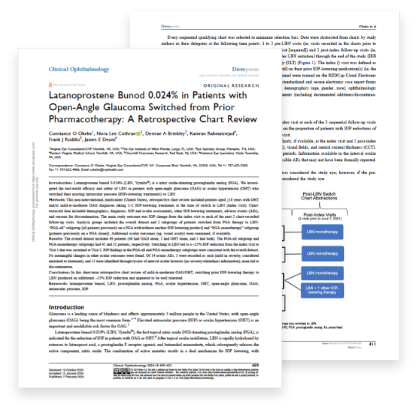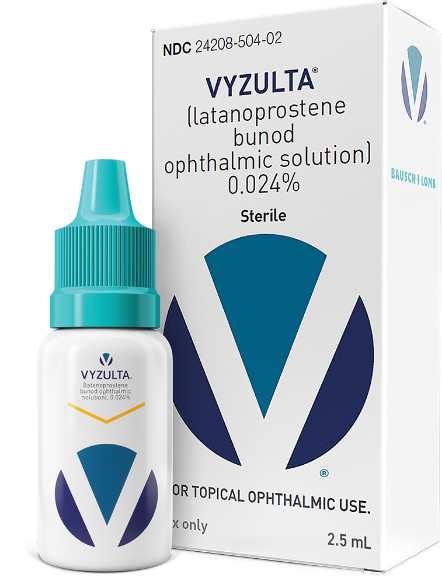Choose monotherapy with VYZULTA in appropriate patients who:
Are starting their open-angle glaucoma or ocular hypertension journey and may benefit from a powerful first-line IOP-lowering treatment1–4
Have inadequately controlled IOP on their current regimen—including1,2,5–7
- Monotherapy
- Combination therapy regimens (PGA and non-PGA)
- Post SLT*
Provide powerful IOP reduction and excellent tolerability with VYZULTA to appropriate patients in your practice, including patients with both high and low baseline IOP.1-3,8
IOP control in the real world

Real-world study: treatment-naïve patients
First-line use of VYZULTA is supported by data from a real-world, multicenter retrospective chart review of treatment-naïve patients with open-angle glaucoma or ocular hypertension.8
DOWNLOAD ARTICLE
Real-world study: switch patients
Switching to VYZULTA is supported by data from a real-world, multicenter retrospective chart review of patients with open-angle glaucoma or ocular hypertension receiving 1 or 2 IOP-lowering therapies who were switched to VYZULTA.9
DOWNLOAD ARTICLEThe results of these studies are based on real-world data and should be considered in the context of the limitations of this type of evidence. While these findings provide insights into the real-world performance of VYZULTA, they may not be directly comparable to results from the clinical trials.
*In clinical trials, patients with a history of SLT in either eye >90 days prior to study entry could be enrolled.6,7
PGA=prostaglandin analog; SLT=selective laser trabeculoplasty.
Sign up
Sign up to receive updates and learn more about VYZULTA.

INDICATION
VYZULTA® (latanoprostene bunod ophthalmic solution), 0.024% is indicated for the reduction of intraocular pressure (IOP) in patients with open-angle glaucoma or ocular hypertension.
IMPORTANT SAFETY INFORMATION
- Increased pigmentation of the iris and periorbital tissue (eyelid) can occur. Iris pigmentation is likely to be permanent
- Gradual changes to eyelashes, including increased length, increased thickness, and number of eyelashes, may occur. These changes are usually reversible upon treatment discontinuation
- Use with caution in patients with a history of intraocular inflammation (iritis/uveitis). VYZULTA should generally not be used in patients with active intraocular inflammation
- Macular edema, including cystoid macular edema, has been reported during treatment with prostaglandin analogs. Use with caution in aphakic patients, in pseudophakic patients with a torn posterior lens capsule, or in patients with known risk factors for macular edema
- There have been reports of bacterial keratitis associated with the use of multiple-dose containers of topical ophthalmic products that were inadvertently contaminated by patients
- Contact lenses should be removed prior to the administration of VYZULTA and may be reinserted 15 minutes after administration
- Most common ocular adverse reactions with incidence ≥2% are conjunctival hyperemia (6%), eye irritation (4%), eye pain (3%), and instillation site pain (2%)
You are encouraged to report negative side effects of prescription drugs to the FDA. Visit www.fda.gov/medwatch or call 1-800-FDA-1088.
Please click here to see full Prescribing Information.
INDICATION
VYZULTA® (latanoprostene bunod ophthalmic solution), 0.024% is indicated for the reduction of intraocular pressure (IOP) in patients with open-angle glaucoma or ocular hypertension.
IMPORTANT SAFETY INFORMATION
- Increased pigmentation of the iris and periorbital tissue (eyelid) can occur. Iris pigmentation is likely to be permanent
References: 1. VYZULTA. Prescribing Information. Bausch & Lomb Inc. 2. Weinreb RN, Ong T, Scassellati Sforzolini B, Vittitow JL, Singh K, Kaufman PL; VOYAGER Study Group. A randomised, controlled comparison of latanoprostene bunod and latanoprost 0.005% in the treatment of ocular hypertension and open-angle glaucoma: the VOYAGER study. Br J Ophthalmol. 2015;99(6):738-745. 3. Weinreb RN, Liebmann JM, Martin KR, Kaufman PL, Vittitow JL. Latanoprostene bunod 0.024% in subjects with open-angle glaucoma or ocular hypertension: pooled phase 3 study findings. J Glaucoma. 2018;27(1):7-15. 4. Okeke CO, Burstein ES, Trubnik V, et al. Retrospective chart review on real-world use of latanoprostene bunod 0.024% in treatment-naïve patients with open-angle glaucoma. Ophthalmol Ther. 2020;9(4):1041-1053. 5. Gordon MO, Beiser JA, Brandt JD, et al. The Ocular Hypertension Treatment Study: baseline factors that predict the onset of primary open-angle glaucoma. Arch Ophthalmol. 2002;120(6):714-720, 829-830. 6. LUNAR. ClinicalTrials.gov identifier: NCT01749930. Updated November 21, 2018. Accessed May 27, 2025. 7. APOLLO. ClinicalTrials.gov identifier: NCT01749904. Updated November 7, 2018. Accessed May 27, 2025. 8. Kawase K, Vittitow JL, Weinreb RN, Araie M; JUPITER Study Group. Long-term safety and efficacy of latanoprostene bunod 0.024% in Japanese subjects with open-angle glaucoma or ocular hypertension: the JUPITER study. Adv Ther. 2016;33(9):1612-1627. 9. Okeke CO, Cothran NL, Brinkley DA, Rahmatnejad K, Rodiño FJ, Deom JE. Latanoprostene bunod 0.024% in patients with open-angle glaucoma switched from prior pharmacotherapy: a retrospective chart review. Clin Ophthalmol. 2024;18:409-422.
